The Microsoft Surface Go LTE Review: Unmatched Mobility
by Brett Howse on January 17, 2019 8:00 AM ESTGPU Performance
The Surface Go features the integrated Intel HD Graphics 615 GPU, and here the advantage of going with a Core based Pentium over an Atom based model in the N Series of processors is more dramatic. The Intel HD 615 features the same 24 execution units as a standard U series Core product, but with a slightly lowered maximum GPU frequency of 850 Mhz compared to something like a Kaby Lake based Core i5 which would be around 1.1 GHz. Intel’s Mobile N Series offers only half the execution units in the Celeron models, and 18 in the Pentium Silver N5000.
We already saw some of this performance delta in the system tests, where PCMark showed somewhat dramatic swings comparing the Pentium Gold 4415Y with the Celeron N4100. Tasks which heavily favored the CPU were somewhat close, but those that leveraged the GPU for gaming or content creation showed a pretty large gain with the Pentium Gold.
Let’s not get ahead of ourselves though. Despite offering twice the execution units as an Atom based processor, this is still an integrated Intel GPU, and therefore it’s going to be slow. It just won’t be quite as slow as an Atom.
Since this is a very low-end GPU, we’ve only run it through our synthetic tests.
3DMark
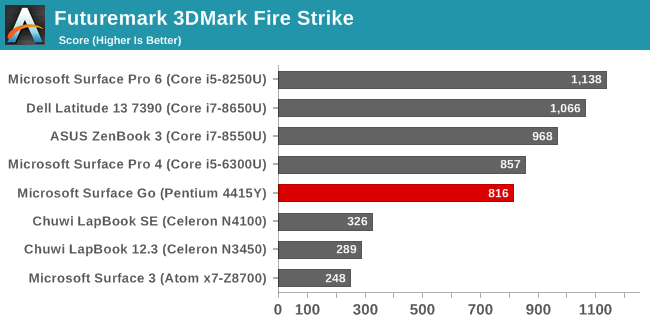
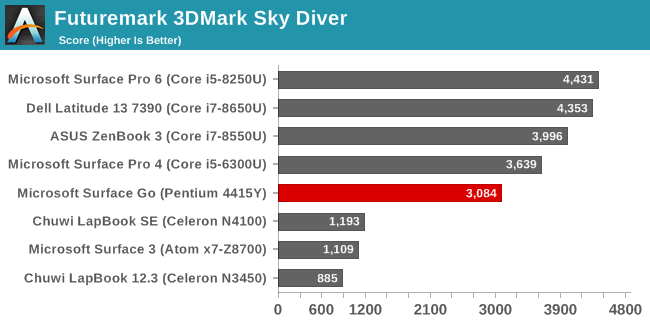

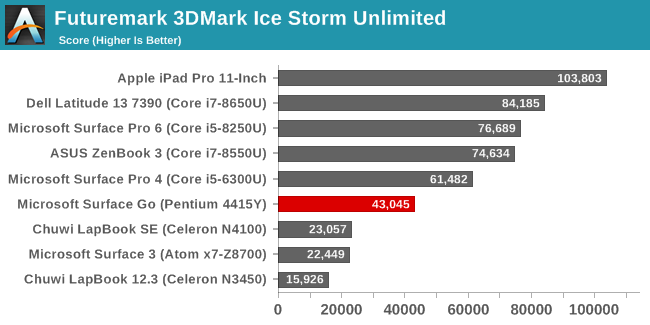
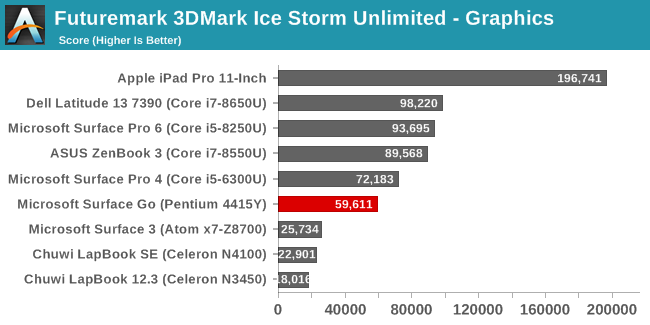
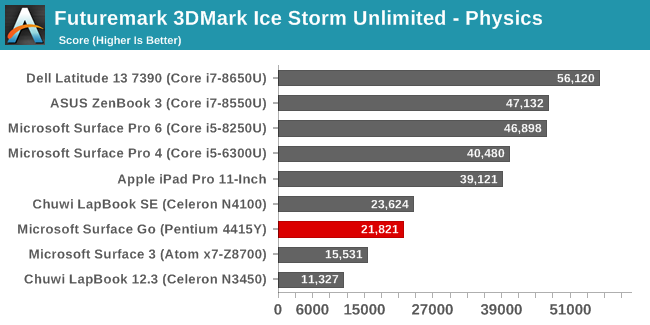
3DMark offers several tests with varying levels of scene complexity, with Fire Strike as the most complex one we run on laptops, followed by Sky Diver, Cloud Gate, and then finally Ice Storm Unlimited which is a test that can also be run on smartphones and tablets.
What’s most interesting is in Fire Strike, if you compare the Kaby Lake based Surface Go with the Skylake based Surface Pro 4, the results are actually quite close. With such a complex scene, the GPU is really the limiting factor more than the CPU, and with both featuring a similar GPU with 24 EUs, the results are really similar, but once the scenes get less complex, the CPU is a larger portion of the task, and the performance drops off fairly dramatically. Ice Storm Unlimited is broken down into the GPU score and the Physics score, with the Physics score being more or less a CPU task, and as we saw on the previous page, the Core i5-6300U is about twice as fast.
Comparing these results to Atom though shows that even though Gemini Lake offers a processor which can meet or beat the Pentium Gold 4415Y, on the GPU side, the meager 12 EUs on Atom are a severe hinderance.
GFXBench
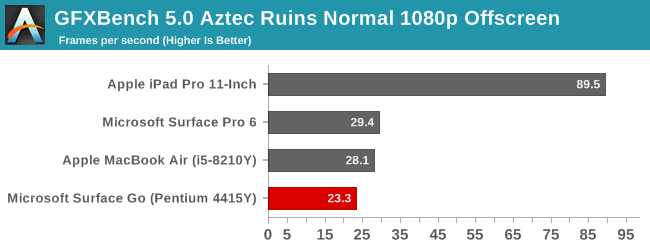
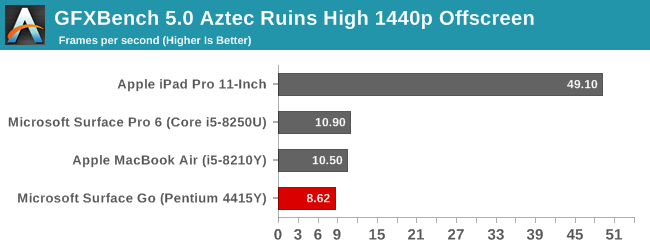
We’re moving over to the latest GFXBench version from Kishonti, which moves away from the OpenGL based tests they offered on Windows, to DirectX 12 with the Aztec Ruins scene. As such, our data is limited, but the results show that the GPU found in the Surface Go is more or less as good as those in higher priced Core offerings, with performance only slightly behind the Surface Pro 6, or even the Y series Apple MacBook Air.
GPU Conclusion
Although the CPU takes a beating when comparing Pentium Gold to Core, the GPU doesn’t suffer the same fate. With the same 24 EUs available as most of the U and Y series Core processors, performance is not hampered quite as much as it is on the CPU side. The overall boost frequency of the GPU is slightly lower compared to a Core i5-6300U, but don’t forget the Pentium Gold 4415Y is also a 6-Watt TDP, so that makes sense. Whereas comparisons on the CPU side with Intel’s latest Atom actually favor the Atom, on the GPU side the Core based Pentium in the Surface Go is much more powerful.
Storage Performance
Microsoft offers two storage offerings in the Surface Go, with the base model being just 64 GB of storage, and the higher tier model features 128 GB. The base model is also eMMC, compared to a true PCIe SSD in the 128 GB model, with the review unit featuring a Toshiba BG3 series. Microsoft moved to a BGA SSD on the Surface Pro in the last couple of models, and the Surface Go also goes with a BGA SSD. That does mean the PCIe interface is just two lanes, which will restrict maximum performance compared to a four-lane model.
The BGA SSD offers good read performance, but write performance with such a small drive takes a big hit. It would be interesting to see this compared to the eMMC version, but we’ve not had a change to test that one. Odds are it would be significantly less performant.


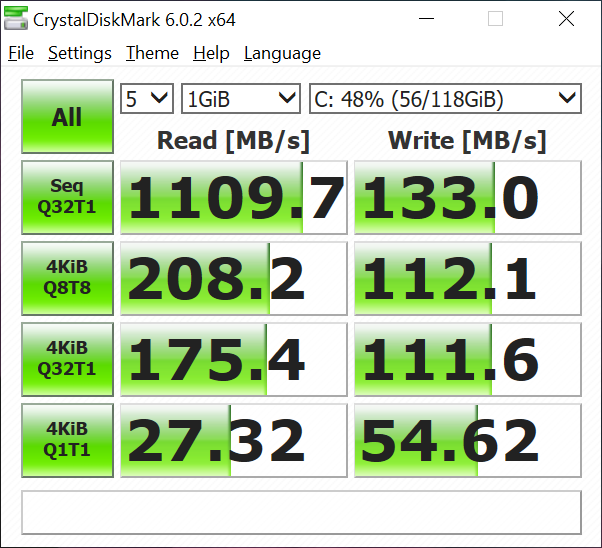








79 Comments
View All Comments
TheinsanegamerN - Thursday, January 17, 2019 - link
Check out the ifixit teardown:https://www.ifixit.com/Teardown/Microsoft+Surface+...
The batteries make up less then half the interior volume, Compared to something like 80-90% for the ipad 6
https://www.ifixit.com/Teardown/iPad+6+Teardown/10...
It appears that not only is the chip much larger, butthe needs for a laptop style heatpipe cooling system eats up a TON of room, not to mention the PCB itself just seems far too large for the minimal components and ports. Perhaps MS's design efficiency leaves a LOT to be desired?
Either way, this is why windows on ARM is so exciting, and why I wish it was a lot further along. It seems ARM packaging is just way more efficient, allowing for far larger batteries. Combined with ARM's greater efficiencies, and x86 tablets like the go wind up with pathetic battery life numbers.
HStewart - Saturday, January 19, 2019 - link
I have never really cared about IFixIt's repair scores - I have had a Surface Pro 1 - since the beginning and it never need repair - only thing I can say able Apple iPad's and iPhone - after a couple of years there battery died.I think MS did a good job on this Surface GO.
TheinsanegamerN - Saturday, January 19, 2019 - link
I'm not referring to the scores. Look at the pictures, at the sheer amount of room in the Go VS the ipad.I cant see how having such poor battery life can be considered good. The OG surface pro had around the same usable life with a more power hungry chip and a compromised battery size.
dontlistentome - Friday, January 18, 2019 - link
Have one of these - 8GB/256GB/LTE/W10pro (and an SP4, Thinkpad X1 Carbon 5 and a Dell 7370).It's fine - it runs all the business apps I need (including some local database work, Python etc). Not perfect but feels much snappier in use that the Surface 3. Happy to take it when I travel knowing I can (bearably) run all I need to do work should the need arise. My 7370 also has LTE and is small, but this is a lot smaller/lighter - to the extent I can dump it in the wife's bag if we're out for the evening, something I never could with the dell.
Is it perfect? No, the Dell is also fanless but manages to cram in a m7 that turbos to 3.5GHz, something I guess I miss when a few processes are busy right after bootup.
As a pointer to the future, I'm happy - a few years from now when the performance distinction will be more based on core count, a Go2 or Go3 with a two core 10th gen fanless chip and decent RAM/SSD combo (which this already has for what most people need). Suspect when I do buy a Go3 though, it'll be Qualcomm inside, not intel.
HStewart - Saturday, January 19, 2019 - link
I doubt the GO3 will have a Qualcomm, by that time Intel will Perfect Sunny Cove - with more power than and battery life than Qualcomm.It is very interesting to me that Qualcomm got Microsoft to create Windows for ARM ( or can we say Windows for Qualcomm ) and yet Microsoft has release single product with it. It seams to me Microsoft does not trust it own OS. They would know better.
KPOM - Sunday, January 20, 2019 - link
It will be interesting if and when Apple either converts the 12” MacBook to the Ax series (A14X is my guess) and/or opens up iOS for iPad. I think ARM has a lot of capabilities and Microsoft is equally aware of them and could optimize Windows for ARM, at least for new applications. However, they are wedded to a lot of legacy x86 code and ARM hasn’t proven very adept at running Win32.Evil Mr M - Saturday, February 2, 2019 - link
FWIW, Costco members in the US can get a Surface Go bundle with 4GB/128SSD plus keyboard for $449.99. That appears NOT to be a sale price, but is limited to Costco members.At that price, it really does challenge an iPad...